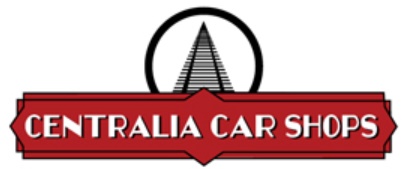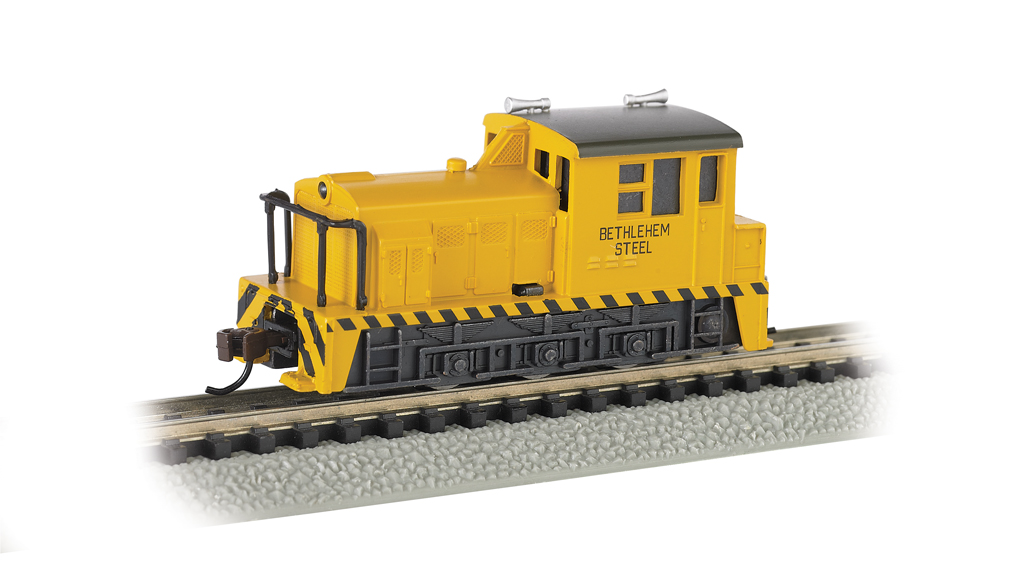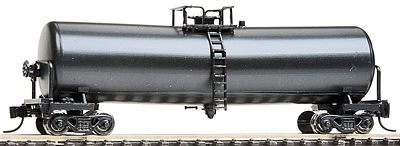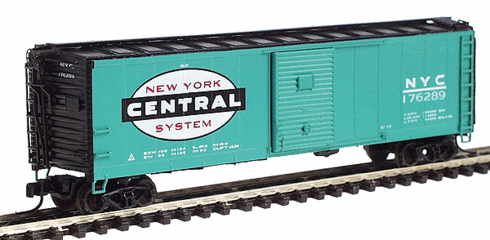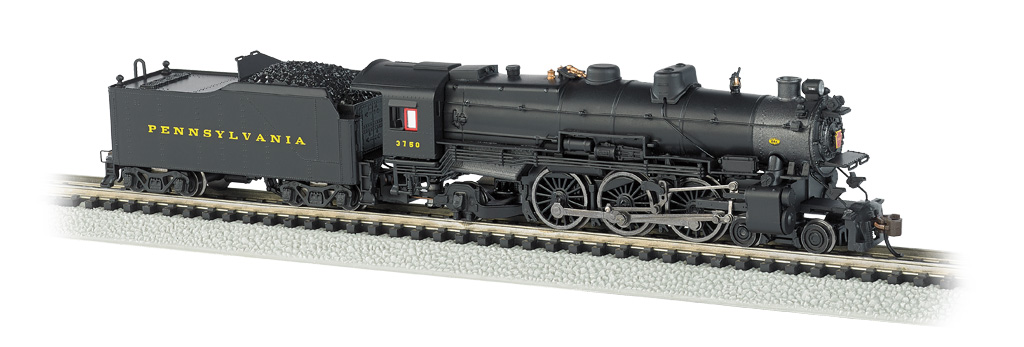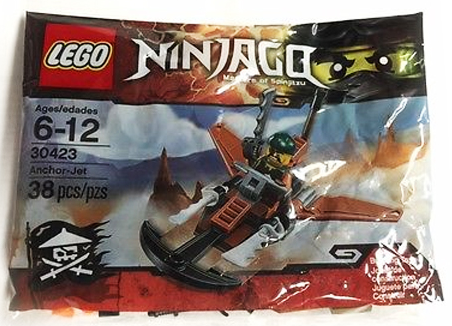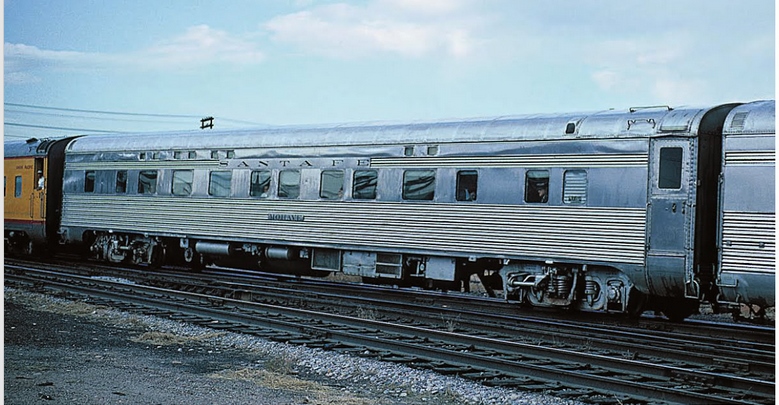Prototype History: The "Imperial" 4-4-2s are among the most popular designs in Lightweight passenger service. They have an excellent array of middle to top level accommodations, with 4 double bedrooms, 4 comfortable compartments and 2 drawing rooms.
The drawing rooms have evolved from the Heavyweight days. The restroom is arranged differently (note that most of the toilets are near the centerline of the car, where their chutes can clear the underbody gear mounted along the car edges.) In place of the section and sofa combo, a sofa and two armchairs provide day accommodations. At night, the sofa folds down into a traditional upper and lower. The third berth is a "Murphy bed" that folds down from a wall locker.
The compartments have a similar arrangement of sofa and chair; being, in effect, miniaturized drawing rooms. The bedrooms are similar again, with less floor space and no chair. The fundamental difference between a "single bedroom" and a "double bedroom" is that the single does not have an upper berth.
There are still a few shortcomings with this design. For example, the compartments and bedrooms still have the open toilets (postwar cars will have these enclosed in tiny restrooms). The compartments also have the prewar style small windows above the main windows. These were originally designed to give the upper berth a window view. However, in these cars, the berths are mounted laterally.
Still, these are excellent cars: requiring only detail refinements to achieve the long-sought perfection of the sleeping car. These versatile 4-4-2s are found on trains throughout the country.
The drawing rooms have evolved from the Heavyweight days. The restroom is arranged differently (note that most of the toilets are near the centerline of the car, where their chutes can clear the underbody gear mounted along the car edges.) In place of the section and sofa combo, a sofa and two armchairs provide day accommodations. At night, the sofa folds down into a traditional upper and lower. The third berth is a "Murphy bed" that folds down from a wall locker.
The compartments have a similar arrangement of sofa and chair; being, in effect, miniaturized drawing rooms. The bedrooms are similar again, with less floor space and no chair. The fundamental difference between a "single bedroom" and a "double bedroom" is that the single does not have an upper berth.
There are still a few shortcomings with this design. For example, the compartments and bedrooms still have the open toilets (postwar cars will have these enclosed in tiny restrooms). The compartments also have the prewar style small windows above the main windows. These were originally designed to give the upper berth a window view. However, in these cars, the berths are mounted laterally.
Still, these are excellent cars: requiring only detail refinements to achieve the long-sought perfection of the sleeping car. These versatile 4-4-2s are found on trains throughout the country.
Road Name History: The Pennsylvania Railroad (reporting mark PRR) was an American Class I railroad, founded in 1846. Commonly referred to as the "Pennsy," the PRR was headquartered in Philadelphia, Pennsylvania.
The PRR was the largest railroad by traffic and revenue in the U.S. for the first half of the twentieth century. Over the years, it acquired, merged with or owned part of at least 800 other rail lines and companies. At the end of 1925, it operated 10,515 miles of rail line; in the 1920s, it carried nearly three times the traffic as other railroads of comparable length, such as the Union Pacific or Atchison, Topeka & Santa Fe railroads. Its only formidable rival was the New York Central (NYC), which carried around three-quarters of PRR's ton-miles.
At one time, the PRR was the largest publicly traded corporation in the world, with a budget larger than that of the U.S. government and a workforce of about 250,000 people. The corporation still holds the record for the longest continuous dividend history: it paid out annual dividends to shareholders for more than 100 years in a row.
In 1968, PRR merged with rival NYC to form the Penn Central Transportation Company, which filed for bankruptcy within two years. The viable parts were transferred in 1976 to Conrail, which was itself broken up in 1999, with 58 percent of the system going to the Norfolk Southern Railway (NS), including nearly all of the former PRR. Amtrak received the electrified segment east of Harrisburg.
The PRR was the largest railroad by traffic and revenue in the U.S. for the first half of the twentieth century. Over the years, it acquired, merged with or owned part of at least 800 other rail lines and companies. At the end of 1925, it operated 10,515 miles of rail line; in the 1920s, it carried nearly three times the traffic as other railroads of comparable length, such as the Union Pacific or Atchison, Topeka & Santa Fe railroads. Its only formidable rival was the New York Central (NYC), which carried around three-quarters of PRR's ton-miles.
At one time, the PRR was the largest publicly traded corporation in the world, with a budget larger than that of the U.S. government and a workforce of about 250,000 people. The corporation still holds the record for the longest continuous dividend history: it paid out annual dividends to shareholders for more than 100 years in a row.
In 1968, PRR merged with rival NYC to form the Penn Central Transportation Company, which filed for bankruptcy within two years. The viable parts were transferred in 1976 to Conrail, which was itself broken up in 1999, with 58 percent of the system going to the Norfolk Southern Railway (NS), including nearly all of the former PRR. Amtrak received the electrified segment east of Harrisburg.
Brand/Importer Information: Centralia Car Shops is an N-Scale manufacturer based in Des Plaines Illinois. It is a wholly owned subsidiary of Des Plaines hobbies. Des Plaines Hobbies was founded by Ron Sebastian in 1984. Centralia subcontracts its manufacturing to InterMountain and 'piggy-backs' the production runs onto the InterMountain runs using the same factories in China as InterMountain. Shipping from factories in China is also coordinated with InterMountain as is distribution to retailers.
Des Plaines Hobbies is a old fashioned hobbyshop with an emphasis on Model Railroading. It was started 33 years ago when you could purchase a tube of glue and sticks of balsa wood. That is still true today, although we have added a few items. About 20 years ago we ventured into some light manufacturing and are also home to Centralia Car Shops, S Scale America, and O Scale America lines of kits, decals and parts. Also along the way we have purchased a few small lines that we still offer such as Microscale's S Scale decal line and Mullet River Model Works HO and S lines.
Des Plaines Hobbies is located 3 1/2 miles north of O Hare International Airport at 1524 Lee/Mannheim (US 12-45). Pace buses conveniently run north and south on Lee/Mannheim from O Hare and the Des Plaines Metra station (1 mile north). For drivers, there is parking for a couple hundred cars out front and on the right side of the store. We are located on the south side of the Jewel food store under the red awning. Come for a visit. ADA restroom available. Coffee is usually hot, if not, ask and we will put a pot on.
Des Plaines Hobbies is a old fashioned hobbyshop with an emphasis on Model Railroading. It was started 33 years ago when you could purchase a tube of glue and sticks of balsa wood. That is still true today, although we have added a few items. About 20 years ago we ventured into some light manufacturing and are also home to Centralia Car Shops, S Scale America, and O Scale America lines of kits, decals and parts. Also along the way we have purchased a few small lines that we still offer such as Microscale's S Scale decal line and Mullet River Model Works HO and S lines.
Des Plaines Hobbies is located 3 1/2 miles north of O Hare International Airport at 1524 Lee/Mannheim (US 12-45). Pace buses conveniently run north and south on Lee/Mannheim from O Hare and the Des Plaines Metra station (1 mile north). For drivers, there is parking for a couple hundred cars out front and on the right side of the store. We are located on the south side of the Jewel food store under the red awning. Come for a visit. ADA restroom available. Coffee is usually hot, if not, ask and we will put a pot on.
Manufacturer Information: Centralia Car Shops is a small brand owned by Des Plaines Hobbies in Chicagoland and distributed by Intermountain Railways.
Here is what Des Plaines Hobbies say about themselves:
Des Plaines Hobbies is a old fashioned hobbyshop with an emphasis on Model Railroading. It was started 33 years ago when you could purchase a tube of glue and sticks of balsa wood. That is still true today, although we have added a few items. About 20 years ago we ventured into some light manufacturing and are also home to Centralia Car Shops, S Scale America, and O Scale America lines of kits, decals and parts. Also along the way we have purchased a few small lines that we still offer such as Microscale's S Scale decal line and Mullet River Model Works HO and S lines.
Here is what Des Plaines Hobbies say about themselves:
Des Plaines Hobbies is a old fashioned hobbyshop with an emphasis on Model Railroading. It was started 33 years ago when you could purchase a tube of glue and sticks of balsa wood. That is still true today, although we have added a few items. About 20 years ago we ventured into some light manufacturing and are also home to Centralia Car Shops, S Scale America, and O Scale America lines of kits, decals and parts. Also along the way we have purchased a few small lines that we still offer such as Microscale's S Scale decal line and Mullet River Model Works HO and S lines.
Item created by: CNW400 on 2020-12-01 13:00:24. Last edited by CNW400 on 2020-12-01 13:00:25
If you see errors or missing data in this entry, please feel free to log in and edit it. Anyone with a Gmail account can log in instantly.
If you see errors or missing data in this entry, please feel free to log in and edit it. Anyone with a Gmail account can log in instantly.




